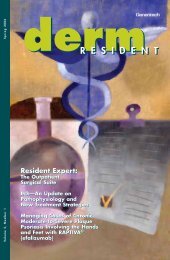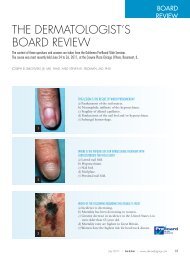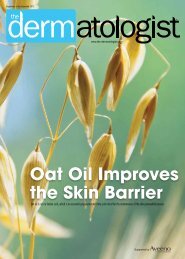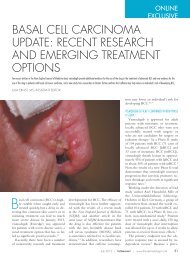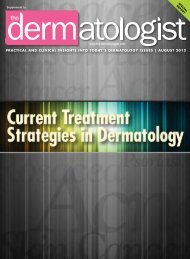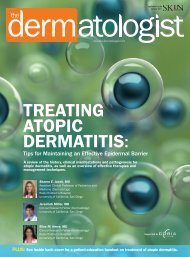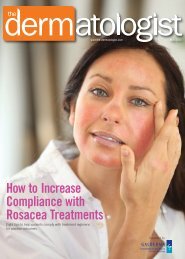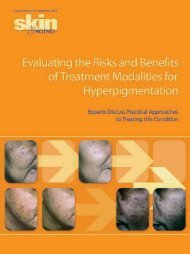Allergen FocusIn this column, we highlight ACDand explore top relevant allergens, regional-and topic-based dermatitis presentationsand clinical tips and pearls fordiagnosis and treatment.<strong>Allergic</strong> Contact Dermatitis <strong>of</strong> <strong>the</strong> FootFoot dermatitis can be a chronic andrecalcitrant condition. Disability frompainful fissures and impaired gait maybe seen. Active dermatitis may lead to aweakened cutaneous barrier, which increases<strong>the</strong> potential risk for infection.Occupational implications also exist, inthat many patients require protective<strong>foot</strong>wear for employment. If an allergyto this protective barrier equipment develops,<strong>the</strong> patient may be forced to seeko<strong>the</strong>r employment.When discussing ACD <strong>of</strong> <strong>the</strong> <strong>foot</strong>,<strong>the</strong>re is a relatively stable microenvironment<strong>of</strong> contactants, composed principally<strong>of</strong> rubber compounds and accelerators,chromates, adhesives, dyes andretained contaminants, such as topicalmedicaments. 9-13 Table 1 highlights<strong>the</strong> most common <strong>of</strong> <strong>the</strong>se allergens.In cultures that tend to favor <strong>the</strong> use<strong>of</strong> <strong>foot</strong>wear, <strong>the</strong> shoe and sock encapsulatethis microenvironment and are<strong>the</strong> source <strong>of</strong> potential allergens. Studieshave estimated that <strong>the</strong> prevalence <strong>of</strong><strong>foot</strong> dermatitis due to shoes ranges from3.3% to 11.7% <strong>of</strong> patch-test patients. 14<strong>The</strong> development <strong>of</strong> ACD <strong>of</strong> <strong>the</strong> <strong>foot</strong> isfavored by friction and <strong>the</strong> hot, humidenvironment within <strong>the</strong> shoe. 15While this may initially appearstraightforward, one realizes on closerinspection that <strong>the</strong> anatomy <strong>of</strong> <strong>foot</strong>wearis quite complex. <strong>The</strong> approach t<strong>of</strong>ootwear can be simplified by consideringfive separate systems: (1) uppers orstraps, (2) soles, (3) insoles, (4) adhesivesand (5) heel and toe stiffeners. 16<strong>The</strong> upper or strap is <strong>the</strong> component<strong>of</strong> <strong>the</strong> <strong>foot</strong>wear that attaches to <strong>the</strong> soleand covers <strong>the</strong> dorsal <strong>foot</strong>. Lea<strong>the</strong>r isTable 1. Top Allergens 14,18AllergenMercaptobenzothiazoleMercapto MixThiuram MixCarba MixMixed Dialkyl ThioureasDithiodimorpholineBlack Rubber MixPotassium DichromateGlutaraldehydeFormaldehydep-tert-butylphenol formaldehyde resin (PTBFR)ColophonyEthyl/Methyl AcrylateDiaminodiphenylmethanecommonly utilized and may <strong>the</strong>reforebe a source <strong>of</strong> chromate exposure, dependingon how <strong>the</strong> lea<strong>the</strong>r was tanned.Some types <strong>of</strong> lea<strong>the</strong>r undergo a multisteptanning process. This process maystart with chromate tanning and involvesubsequent tanning with formaldehydeor glutaraldehyde. 12,16 In a retrospectiveanalysis published in 2007 by <strong>the</strong> NorthAmerican Contact Dermatitis Group(NACDG), potassium dichromate wasfound to be <strong>the</strong> second-most frequentshoe-related allergen. Only <strong>the</strong> adhesivep-tert-butylphenol-formaldehyde resinFoot dermatitis can be a chronic and recalcitrant condition.Disability from painful fissures and impaired gait may be seen.Active dermatitis may also lead to a weakened cutaneousbarrier, which increases <strong>the</strong> potential risk for infection.Occupational implications also exist, in that many patientsrequire protective <strong>foot</strong>wear for <strong>the</strong>ir employment.NickelPreservatives(PTBFR) was more frequently positiveon patch testing. 14<strong>The</strong> sole <strong>of</strong> a shoe is <strong>the</strong> base. <strong>The</strong>chemical composition <strong>of</strong> <strong>the</strong> sole dependson <strong>the</strong> type <strong>of</strong> shoe; lea<strong>the</strong>r, neoprene,polyurethane and various types <strong>of</strong>rubber are commonly used. Neopreneis oil-resistant and commonly foundin <strong>the</strong> sole <strong>of</strong> occupational <strong>foot</strong>wear. 16LocationRubberRubberRubberRubberRubberRubberRubberLea<strong>the</strong>rLea<strong>the</strong>rLea<strong>the</strong>rAdhesivesAdhesivesAdhesivesPolyurethaneLace eyelets, bucklesBiocidesWhile overall <strong>the</strong> single most commonshoe allergen in North America appearsto be PTBFR followed by chromate,taken as a group, rubber additives causea greater number <strong>of</strong> reactions. 14 In o<strong>the</strong>rwords, rubber-related chemicals are <strong>the</strong>most common shoe allergen categoryoverall. This group includes carba mix,thiuram mix, mercaptobenzothiazole(MBT), mercapto mix, mixed dialkylthioureas, dithiodimorpholine (DTDM)and black rubber mix.<strong>The</strong> insole provides cushion and archsupport. <strong>The</strong> composition <strong>of</strong> <strong>the</strong> insolemay be lea<strong>the</strong>r, polyurethane, neopreneor a composite <strong>of</strong> rubber or paper fibers.Composite fiber insoles are cheaperand may be found in less expensive<strong>foot</strong>wear. <strong>The</strong>se fibers are typically heldtoge<strong>the</strong>r by a resinous glue. To preventmicrobial degradation <strong>of</strong> <strong>the</strong>se fibers, abiocides (preservative) is also typicallyadded. 16 Insoles <strong>of</strong> a shoe come in directcontact with <strong>the</strong> sock and plantar<strong>foot</strong> region. While <strong>the</strong> plantar <strong>foot</strong> is innatelyresistant to ACD (because to <strong>the</strong>relatively thick skin <strong>of</strong> this region), <strong>the</strong>reare several key factors that can lead tosensitization. Potential sensitizing haptens<strong>of</strong> <strong>the</strong> insole may be released withheat, friction and sweat over time. Becausemost socks are porous, potentialallergens leached from <strong>the</strong> insole infil-November 2012 | <strong>The</strong> <strong>Dermatologist</strong> ® | www.<strong>the</strong>-dermatologist.com 21
Allergen FocusTable 2. Differential Diagnosis <strong>of</strong> <strong>Allergic</strong> Contact Dermatitis <strong>of</strong> <strong>the</strong> Foot 18,19Diagnosis Clinical Presentation CommentsACD <strong>of</strong> <strong>the</strong> <strong>foot</strong> (upper/strap) Dorsal <strong>foot</strong> dermatitis sparing <strong>the</strong> interdigital spaces. Classic “shoe pattern dermatitis”ACD <strong>of</strong> <strong>the</strong> <strong>foot</strong> (insole) Plantar dermatitis sparing <strong>the</strong> plantar arch and proximal creases <strong>of</strong> <strong>the</strong> toes. Typically spares areas most involved in palmoplantar pustulosis.ACD <strong>of</strong> <strong>the</strong> <strong>foot</strong> (sole)Can present as plantar dermatitis or as localized plaques <strong>of</strong> dermatitis on <strong>the</strong>thighs/buttock in patients with a habit <strong>of</strong> sitting with <strong>the</strong>ir legs folded and<strong>the</strong>ir feet underneath <strong>the</strong>m.ACD <strong>of</strong> <strong>the</strong> <strong>foot</strong> (stiffeners) Dermatitis involving <strong>the</strong> dorsal toes and heels. Major differential for heel involvement is irritant dermatitis.ACD <strong>of</strong> <strong>the</strong> <strong>foot</strong> (adhesives)Irritant dermatitisMay present with dorsal <strong>foot</strong> dermatitis, plantar dermatitis or heel and toedermatitis.Parched and glazed appearance <strong>of</strong> skin with fine scaling that favors <strong>the</strong> heelsor bridges <strong>the</strong> dorsal toes and <strong>foot</strong> in an “apron pattern.”Heel irritant dermatitis is seen more <strong>of</strong>ten with frequent wearing<strong>of</strong> open back shoes such as flip flops. <strong>The</strong> apron pattern ismore <strong>of</strong>ten seen with atopic dermatitis.Atopic Dermatitis Favors <strong>the</strong> dorsal <strong>foot</strong> in childhood and <strong>the</strong> palmoplantar skin in adulthood. Look for o<strong>the</strong>r atopic stigmata such as Dennie-Morgan lines,allergic shinners, and hyperlinear <strong>the</strong>nar eminences.Nummular DermatitisJuvenile Plantar DermatosisPompholyxDyshidrotic EczemaPsoriasisPalmoplantar pustulosisPityriasis rubra pilarisTinea pedisDiscrete, coin-shaped crusted plaques on <strong>the</strong> dorsal <strong>foot</strong>.Smooth and glazed appearance with fine scaling localized to <strong>the</strong> plantar aspect<strong>of</strong> <strong>the</strong> fore<strong>foot</strong> and toes with sparing <strong>of</strong> <strong>the</strong> interdigital spaces.Severe sudden outbreaks <strong>of</strong> intensely pruritic vesicles symmetrically on <strong>the</strong>palms, soles and lateral aspects <strong>of</strong> <strong>the</strong> digits.Similar to pompholyx but more <strong>of</strong> a subacute to chronic clinical presentationra<strong>the</strong>r than an acute sudden outbreak.Well-demarcated, ery<strong>the</strong>matous plaques with micaceous scale can be seen on<strong>the</strong> dorsal <strong>foot</strong>. Plantar lesions tend to be more hyperkeratotic and <strong>of</strong>ten havea pustular quality. Nail pitting.Bilateral and symmetric ery<strong>the</strong>matous plaques studded with minute pustuleson <strong>the</strong> central palms and soles.Salmon-orange appearing hyperkeratosis <strong>of</strong> <strong>the</strong> plantar <strong>foot</strong> extending up <strong>the</strong>sides in <strong>the</strong> so-called “sandal pattern.” Rarely associated with nail pitting.Dull ery<strong>the</strong>ma and fine scale on <strong>the</strong> sole and sides <strong>of</strong> <strong>the</strong> feet in a “moccasinor sandal pattern.” May see similar fine scaling on one palm giving a “onehand, two feet pattern.”Also known as dermatitis plantaris sicca or “sweaty sockdermatitis.”Keratoderma blenorrhagicum is a plantar eruption characteristic<strong>of</strong> reactive arthritis (Reiter Syndrome).Associated with smoking and thyroid disorders. Likely a localizedacral variant <strong>of</strong> psoriasis.KOH positive for dermatophyte hyphae is diagnostic.T. mentagrophytes can produce a bullous tinea that favors <strong>the</strong>plantar arch.trate <strong>the</strong> textile matrix easily. This createsa reservoir <strong>of</strong> potential allergens indirect contact with <strong>the</strong> skin <strong>of</strong> <strong>the</strong> <strong>foot</strong>for prolonged periods <strong>of</strong> time. <strong>The</strong>normally robust cutaneous barrier <strong>of</strong><strong>the</strong> plantar <strong>foot</strong> may also be diminishedbecause <strong>of</strong> o<strong>the</strong>r conditions like eczemaor dermatophyte infection.Adhesives are necessary in <strong>the</strong> majority<strong>of</strong> <strong>foot</strong>wear for assembly. <strong>The</strong>seglues are used to attach <strong>the</strong> insole to<strong>the</strong> sole and to bind various components<strong>of</strong> <strong>the</strong> shoe top toge<strong>the</strong>r. <strong>The</strong>y area major source <strong>of</strong> shoe allergy. As mentioned,<strong>the</strong> primary relevant shoe adhesivefound on patch testing to cause<strong>foot</strong> dermatitis is <strong>the</strong> phenolic resinPTBFR. PTBFR has been shown toaccount for 10% to 20% <strong>of</strong> allergic reactionsto <strong>foot</strong>wear. 15,16 It has been usedas an additive in rubber glues since <strong>the</strong>1950s and is ideally suited for <strong>foot</strong>wearmanufacturing due to its strong adhesionto both lea<strong>the</strong>r and rubber. 17Heel and toe stiffeners are alsoknown as counters. This component <strong>of</strong><strong>the</strong> shoe is meant to retain <strong>the</strong> overallshape <strong>of</strong> <strong>the</strong> shoe while streng<strong>the</strong>ning<strong>the</strong> heel and toe. Stiffeners have aspectrum <strong>of</strong> complexity, ranging from asimple layer <strong>of</strong> inert adhesive to a complexweb <strong>of</strong> polyester or cotton. Similarto insoles, stiffeners can be a source <strong>of</strong>exposure to rubber compounds, adhesivesand biocides. 16Differential Diagnosis<strong>The</strong> differential diagnosis for an eczematouseruption <strong>of</strong> <strong>the</strong> <strong>foot</strong> can beclinically challenging. A categorical approachis helpful. <strong>The</strong> majority <strong>of</strong> casescan be sorted into one <strong>of</strong> <strong>the</strong> followingprinciple categories: (1) exogenousdermatitis, (2) endogenous dermatitis,(3) acral papulosquamous entities, (4)infectious entities and (5) hybrid dermatitis.18,19 Table 2 highlights this differentialdiagnosis.Exogenous dermatitis includes bothirritant and allergic contact dermatitis.<strong>The</strong> morphology <strong>of</strong> this group is <strong>the</strong>prototypical spectrum <strong>of</strong> acute, subacuteand chronic eczematous eruptions. Itis typical to see a poorly demarcated,spreading, ery<strong>the</strong>matous and edematous,papulovesicular eruption. However, as<strong>the</strong> lesions progress along <strong>the</strong> spectrumto a more chronic state, <strong>the</strong>re is morescaling and lichenification, which cancause some confusion clinically with<strong>the</strong> papulosquamous eruptions. Symptomatologyis useful in that pruritusfavors an allergic etiology and burningand stinging are more <strong>of</strong>ten seen withirritant etiologies. Finally, regional distributionis important to note. <strong>The</strong> clas-22 November 2012 | <strong>The</strong> <strong>Dermatologist</strong> ® | www.<strong>the</strong>-dermatologist.com



